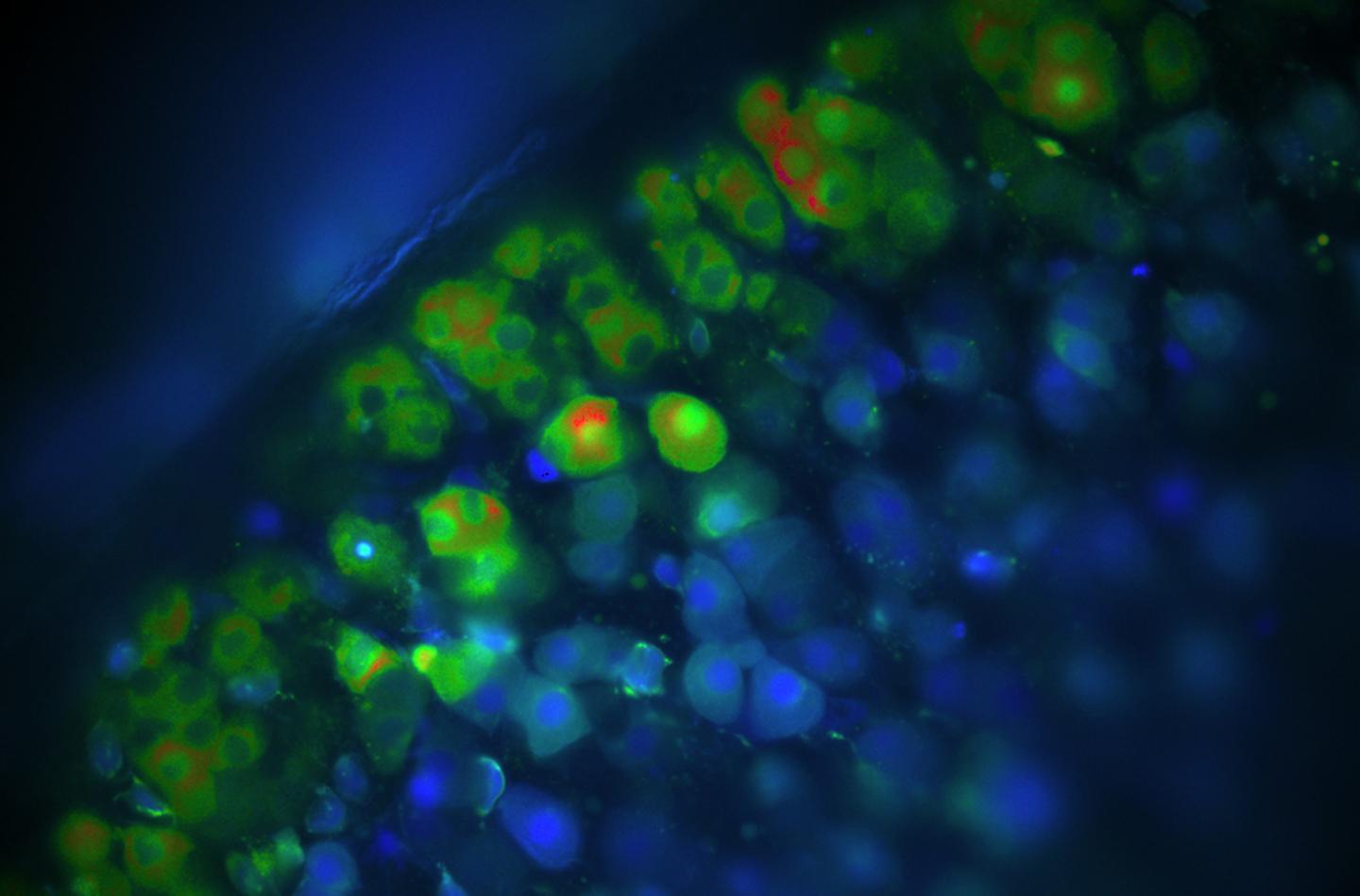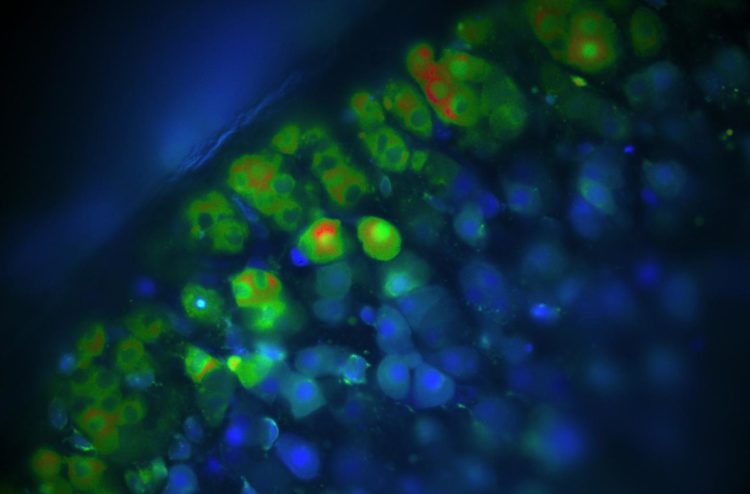
Credit: Audrey H. Soria, FMP
When the adrenal gland produces too much aldosterone, this often leads to high blood pressure and kidney damage (hyperaldosteronism). It has only recently emerged that several patients harbor a mutation in the gene for the ClC-2 chloride channel. Researchers led by Professor Thomas Jentsch have now been able to show for the first time how the altered channels cause the disease. Their results are reported in the journal Nature Communications.
The steroid hormone aldosterone, in concert with other mechanisms, controls our blood pressure. It is secreted by the adrenal glands and regulates the water and salt balance in the body. Adrenal glands in patients affected by hyperaldosteronism produce excessive amounts of aldosterone, which leads to excessive sodium retention which in turn increases the excretion of potassium. In the end, this leads to abnormally high blood pressure, ‘arterial hypertension’. The combination of high aldosterone concentration and high blood pressure often results additionally in kidney damage.
The pathological mechanisms of the disease, also known as Conn syndrome, remained incompletely understood. In 2018, Paris-based scientists around Prof. Maria-Christina Zennaro teamed up with colleagues from the Leibniz-Forschungsinstitut fuer Molekulare Pharmakologie (FMP) and the Max Delbrueck Center (MDC) as well as other scientists in Germany and the USA around Prof. Ute Scholl from the Berlin Institute of Health (BIH) and Charite, and found mutations in the ClC-2 chloride channel in patients affected by this syndrome. To date, a total of six different mutations have been described (published in Nature Genetics 2018). However, the pathway leading from the mutations to aldosterone overproduction had remained unclear – until researchers from FMP and MDC generated and analyzed a specific mouse model.
Proven causality between mutation and disease
The team, led by Prof. Thomas Jentsch – a pioneer who discovered the first chloride channel family, including ClC-2, almost three decades ago, initially investigated all known aldosteronism-causing ClC-2 mutations in vitro. They found that all these mutations drastically increased the flow of chloride through the channel.
To examine the hypothesis that increased chloride flow through ClC-2 causes hyperaldosteronism, the researchers then developed a mouse model in which ClC-2 was activated by an ‘artificial’ mutation that had not been reported for patients. The genetically modified mice exhibited enormously increased chloride currents in aldosterone-secreting cells, which indirectly led to a large increase in aldosterone concentration in the blood of those rodents. Just like in patients, this resulted in abnormally elevated blood pressure and secondarily reduced activity of renin, a hormone that normally boosts aldosterone production. In addition to proving that an increase in Cl- currents in adrenal gland cells leads to hyperaldosteronism, the researchers investigated the pathological pathway in great detail.
Chloride channel continuously open
“We have seen how the channel is constantly open due to these mutations, which greatly changes the electrical voltage across the membrane of the hormone-producing cell. This leads to an influx of calcium, which, in turn, causes overproduction of aldosterone,” explains Dr. Corinna Goeppner, who, together with Dr. Ian Orozco, is the first author of the article which was just published in Nature Communications.
“We have been able to show step by step what exactly happens in the organism due to the mutated chloride channel in our model for the first time,” said the biologist. “In this respect, our work has excellently complemented and expanded the human genetic findings.”
The best model to explore hyperaldosteronism
The mouse model developed in Berlin Buch is the first in-vivo model that faithfully models all symptoms of the disease. Therefore, it is the perfect model to investigate the pathological mechanisms of hyperaldosteronism and to identify secondary effects such as long-term damage. The researchers were already able to detect slight kidney damage, but they hope more effects will be discovered: “At the moment, we assume that a constitutively open chloride channel could also impact other organs,” says group leader Thomas Jentsch. Unfortunately, this is still a grey area in medicine, although the long-term consequences are highly relevant for patients. “Our mouse model can definitely help to clarify the situation. This reaffirms once again, how relevant basic research can be for clinical applications.” (fmp)
###
Publication
Corinna Goeppner, Ian J. Orozco et al. (2019): “Pathogenesis of hypertension in a mouse model for human CLCN2 related hyperaldosteronism”. Nature Communications, DOI: 10.1038/s41467-019-12113-9.
Max Delbrueck Center for Molecular Medicine
The Max Delbrueck Center for Molecular Medicine in the Helmholtz Association (MDC) was founded in Berlin in 1992. It is named for the German-American physicist Max Delbrueck, who was awarded the 1969 Nobel Prize in Physiology and Medicine. The MDC’s mission is to study molecular mechanisms in order to understand the origins of disease and thus be able to diagnose, prevent and fight it better and more effectively. In these efforts the MDC cooperates with the Charite – Universitaetsmedizin Berlin and the Berlin Institute of Health (BIH) as well as with national partners such as the German Center for Cardiovascular Research and numerous international research institutions. More than 1,600 staff and guests from nearly 60 countries work at the MDC, just under 1,300 of them in scientific research. The MDC is funded by the German Federal Ministry of Education and Research (90 percent) and the State of Berlin (10 percent), and is a member of the Helmholtz Association of German Research Centers. For more information, please visit http://www.
Leibniz-Forschungsinstitut fuer Molekulare Pharmakologie (FMP)
The Leibniz-Forschungsinstitut für Molekulare Pharmakologie (FMP) is part of the Forschungsverbund Berlin e.V. (FVB), who legally represents eight non-university research institutes – members of the Leibniz Association – in Berlin. The institutions pursue common interests within the framework of a single legal entity while maintaining their scientific autonomy. More than 1,900 employees work within the research association. The eight institutes were founded in 1992 and emerged from former institutes of the GDR Academy of Sciences.
Media Contact
Jana Schluetter
[email protected]
49-030-940-62121
Related Journal Article
http://dx.





